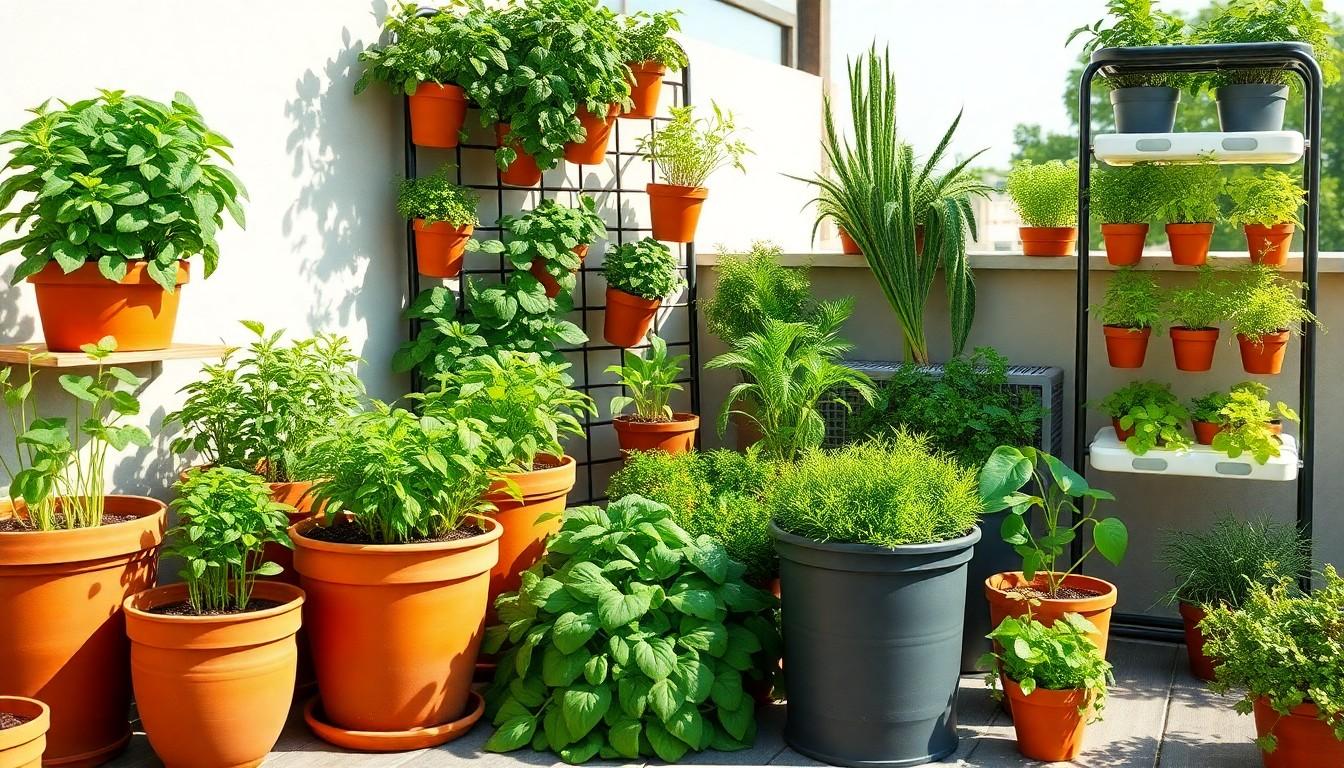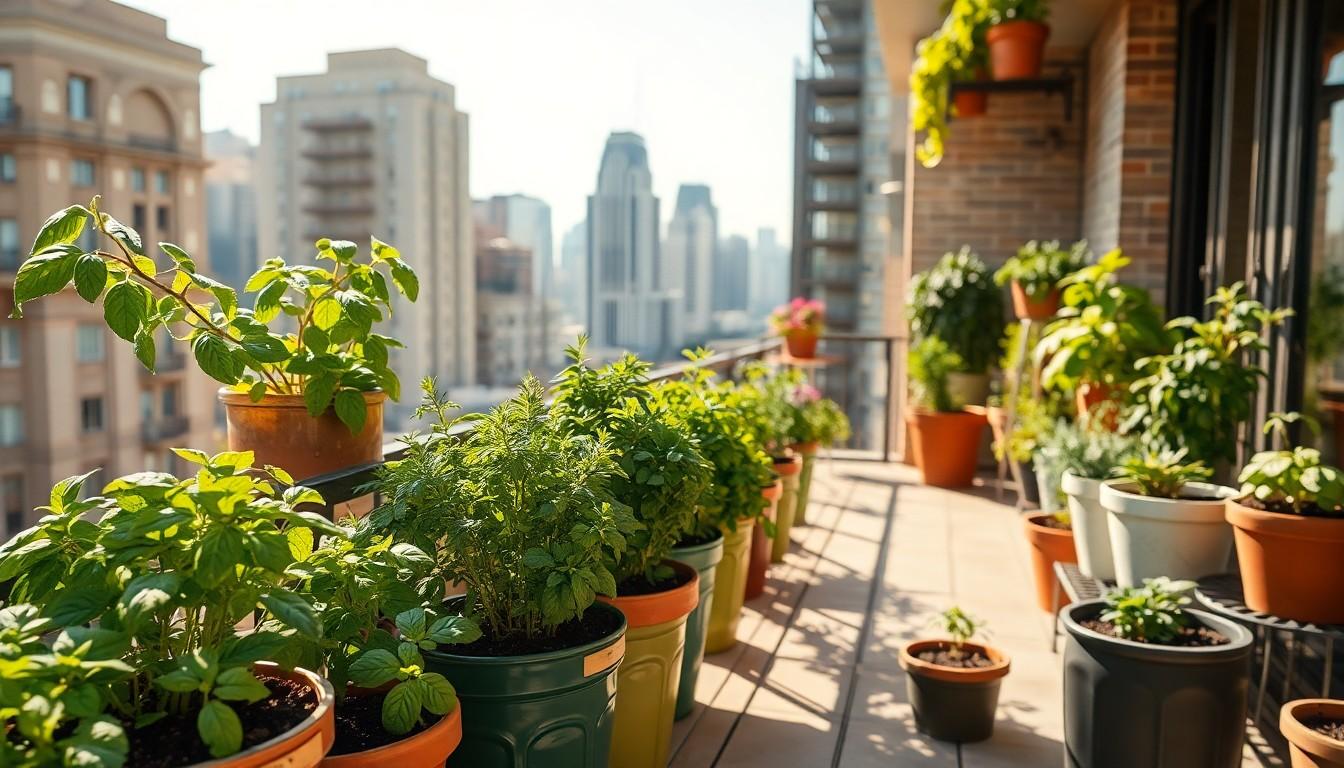Imagine stepping into your kitchen and plucking fresh basil or mint straight from your very own herb garden. Sounds dreamy, right? With herb growing containers, that dream can become a reality—even if you live in a shoebox apartment or have a black thumb. These handy little vessels are the secret to cultivating your own mini jungle of flavor, no matter the space constraints.
Not only do herb growing containers make gardening accessible, but they also add a splash of greenery to your home. Plus, they’re like a personal chef, ready to elevate your dishes with fresh ingredients. Say goodbye to those sad, wilted herbs from the grocery store. It’s time to unleash your inner gardener and transform your cooking with the vibrant flavors of homegrown herbs.
herb growing containers
Herb growing containers come in various sizes, shapes, and materials, making them adaptable to different gardening needs. These containers support optimal growth by ensuring proper drainage and air circulation. Materials such as terracotta, plastic, and metal each offer unique benefits, with terracotta providing breathability and plastic lightweight convenience.
Dimensions vary, catering to individual preferences. A standard size for herb containers typically ranges from 6 to 12 inches in diameter. Specific herbs thrive in specific container sizes; for example, basil prefers larger pots while chives can flourish in smaller ones. Different container styles, such as window boxes and hanging pots, allow for creative gardening options, even in limited spaces.
Draining holes play a crucial role in preventing overwatering. Proper moisture levels help avoid root rot, which can be detrimental to herbs. Containers need regular monitoring to maintain the right balance of moisture. Some gardeners choose self-watering containers, which have built-in reservoirs that simplify maintenance.
Placement also affects herb growth. Sunlight exposure remains essential for most herbs, requiring at least 6 hours of direct light daily. Placing containers near windows or in sunny balconies enhances growth potential. Herbs like mint and parsley can also adapt to partial shade, offering flexibility in choosing locations.
Fertilization further supports healthy growth. Organic fertilizers are beneficial, providing necessary nutrients without the risk of chemical residues affecting the herbs. Regularly checking for pests ensures that plants remain healthy and productive. A proactive approach promotes thriving herb gardens in containers.
Types of Herb Growing Containers

Herb growing containers come in various types, each suited for specific needs and spaces.
Pots and Planters
Pots and planters rank among the most common containers for growing herbs. Materials like terracotta, plastic, and ceramic help to regulate moisture and temperature. Sizes vary significantly, accommodating everything from single herb plants to larger arrangements. Drainage holes play a crucial role in preventing overwatering, ensuring that roots remain healthy. Additionally, decorative options enhance aesthetic appeal, making them suitable for both indoor and outdoor settings.
Vertical Garden Systems
Vertical garden systems maximize space by allowing herb cultivation in a stacked format. These designs optimize sunlight exposure, essential for herbal growth. Different styles include wall-mounted pockets, shelves, or towers filled with growing trays. Some systems utilize a drip irrigation setup, providing consistent moisture while conserving water. This option suits small apartments or patios where floor space is limited, making it easier to incorporate greenery into daily life.
Hydroponic Containers
Hydroponic containers facilitate soil-free herb growth through nutrient-rich water. This method provides precise control over nutrients, promoting faster growth rates. Often seen in specialized kits, these containers allow for perfect water oxygenation and drainage. Users can cultivate herbs in small spaces while eliminating soil pests, ensuring clean and fresh produce. Various designs are available, from simple systems to elaborate setups tailored for experienced gardeners.
Benefits of Using Herb Growing Containers
Herb growing containers offer numerous advantages for cultivating fresh herbs at home, even in limited spaces. They make gardening accessible while enhancing the overall environment.
Space Efficiency
Space efficiency plays a crucial role in urban gardening. Small containers accommodate fresh herbs on balconies or windowsills. Vertical containers further maximize available space, allowing stacked plant arrangements. Growing herbs in containers reduces reliance on traditional garden beds, freeing up yard space for other uses. Successful herb growing emerges regardless of outdoor or indoor locations, ensuring anyone can enjoy homegrown flavor.
Mobility and Flexibility
Mobility and flexibility enhance the herb growing experience. Containers allow easy movement to capture optimal sunlight throughout the day. Changing the location of containers can help protect herbs from harsh weather, pests, or diseases. Switching between indoor and outdoor environments increases exposure to natural elements, promoting healthy growth. With their lightweight designs, containers make it simple to adapt gardening arrangements to personal preferences and seasonal changes.
Choosing the Right Herb Growing Container
Selecting the appropriate herb growing container enhances the overall gardening experience and ensures robust herb growth. Various factors contribute to this decision, including materials, size, and drainage properties.
Material Considerations
Materials play a crucial role in the effectiveness of herb growing containers. Terracotta offers breathability while aiding in moisture regulation, making it ideal for many herbs. Conversely, plastic containers are lightweight and convenient for urban settings. Metal can impart heat quickly, but insulation considerations must be made. Ceramic pots bring aesthetic appeal but may require more careful handling due to fragility. Each material affects the temperature and moisture retention of the soil, directly impacting the growth of herbs.
Size and Drainage
Container size significantly influences herb health and yield. Small herbs, like basil, thrive in containers about 6 to 8 inches deep, while larger varieties, such as rosemary, prefer at least 10 to 12 inches. Drainage holes serve as essential features for preventing overwatering, which can lead to root rot and other growth issues. Cultivators must ensure that containers provide proper drainage while maintaining adequate soil moisture. An optimal balance between container depth and drainage ensures productive herbs flourish, regardless of the gardener’s experience level.
Popular Herbs for Container Gardening
Basil thrives in containers, offering a fragrant addition to any culinary dish. Chives provide a mild onion flavor, perfect for salads and sauces. Cilantro stands out for its fresh taste, enhancing salsas and guacamole. Dill adds a unique flavor, especially to pickles and dressings.
Mint grows vigorously in pots, delivering refreshing tea and cocktail options. Oregano offers robust flavor, ideal for Mediterranean dishes. Parsley’s versatility makes it a staple in numerous recipes. Rosemary brings an earthy aroma, enhancing roasted meats and vegetables.
Sage complements rich flavors in stuffing and marinades. Thyme’s delicate taste pairs well with soups and stews. Each of these herbs adapts well to a variety of container sizes, providing flexibility for gardeners. Small containers work for herbs like chives and parsley, while larger pots suit rosemary and sage.
Sunlight plays a crucial role; most herbs require six hours of direct light daily to thrive. Providing good drainage helps prevent overwatering, which can harm delicate roots. Choosing high-quality potting soil enriches growth and nutrient absorption.
Growing herbs in containers not only saves space but also enhances accessibility, making it easy to harvest fresh ingredients. Regular pruning encourages bushier growth and prevents flowering, which can change flavor profiles. Monitoring for pests ensures vibrant, healthy plants that flourish in any environment.
daily life with fresh aromas and tastes
Herb growing containers offer a fantastic way to cultivate fresh herbs right at home. They provide flexibility and accessibility for anyone interested in gardening, regardless of experience. With the right container, it’s possible to create a thriving herb garden in even the smallest spaces.
Choosing the appropriate size and material ensures optimal growth while maximizing sunlight exposure. By monitoring drainage and providing proper care, gardeners can enjoy a bountiful harvest of flavorful herbs. Embracing this gardening method not only enhances culinary experiences but also brings a touch of nature indoors, enriching daily life with fresh aromas and tastes.

